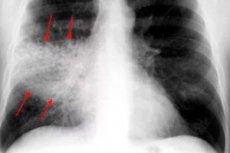Medical expert of the article
New publications
Causes and pathogenesis of pleuropneumonia
Last reviewed: 04.07.2025

All iLive content is medically reviewed or fact checked to ensure as much factual accuracy as possible.
We have strict sourcing guidelines and only link to reputable media sites, academic research institutions and, whenever possible, medically peer reviewed studies. Note that the numbers in parentheses ([1], [2], etc.) are clickable links to these studies.
If you feel that any of our content is inaccurate, out-of-date, or otherwise questionable, please select it and press Ctrl + Enter.

Lobar bacterial pneumonia, or focal non-segmental pneumonia, or acute croupous inflammation of the lobes of the lung, affecting part of its serous membrane (pleura) can be diagnosed as pleuropneumonia, although this definition is not included in the ICD-10 class of diseases of the respiratory system.
Obviously, this is due to the fact that pleurisy – dry or with pleural effusion – is most often considered a consequence, that is, a complication of streptococcal and staphylococcal pneumonia, which occurs, although not always, but at least in three or four cases out of ten.
Cause
Pneumonia is caused by infection, and the most common cause of pleuropneumonia (lobar pneumonia) has always been and is still considered to be pneumococcus Streptococcus pneumoniae - an α-hemolytic streptococcus, an anaerobe (which is part of the nasopharyngeal microbiota in healthy people).
Clinical studies have identified other causes of pleuropneumonia, including pathogens such as:
- gamma-proteobacterium Klebsiella pneumoniae (Friedlander's bacillus);
- encapsulated and non-encapsulated strains of Haemophilus influenzae (Pfeiffer bacilli) – a commensal bacterium of the upper respiratory tract;
- MRSA – methicillin-resistant Staphylococcus aureus (golden staph), which causes pleural effusion pneumonia;
- Streptococcus pyogenes, a group A β-hemolytic streptococcus, present on the mucous membrane of the pharynx;
- Pseudomonas aeruginosa (blue pus bacillus), which causes nosocomial (hospital-acquired) pneumonia;
Among the rarer infections, pulmonologists name the aquatic non-spore-forming gram-negative bacilli Legionella pneumophila, which when inhaled can cause severe pneumonia (with a fatality rate of up to 7-8%), as well as Mycoplasma pneumonia. The bacterium M. pneumoniae, spread by airborne droplets and contact, usually causes mild respiratory infections, and the most common of these diseases is tracheobronchitis. However, as practice shows, in pediatric patients M. pneumoniae plays a certain role in the development of community-acquired pneumonia (up to 56-59% of cases among children aged four to six years).
Pleuropneumonia may be a consequence of extensive parasitic invasions, in particular, ascariasis in children. Also read - Causes of acute pneumonia in children
Risk factors
The predisposing factors for the development of pleuropneumonia are the same as for any pneumonia, and include:
- asymptomatic carriage of bacteria, in particular, pneumococci Streptococcus pneumoniae (recorded in different parts of the world at levels ranging from 13% to 87%);
- infectious and inflammatory complications after influenza;
- chronic diseases of the upper and lower respiratory tract, in particular, acute respiratory infections, tracheitis and bronchitis;
- smoking and alcohol addiction;
- temporary decrease in immunity and persistent immunodeficiency states;
- prolonged bed rest (or forced lying down in certain conditions), leading to deterioration of pulmonary ventilation;
- hereditary and autoimmune fibroses associated with systemic scleroderma, lupus erythematosus, cystic fibrosis.
Risk factors for hospital-acquired pneumonia include the use of inhalation anesthesia (during surgical interventions), tracheal intubation and artificial ventilation.
Pathogenesis
As is known, the structural elements of the lungs are lobes consisting of segments, the tissue of which is lobules. The pulmonary lobes are surrounded on the outside by a thin connective tissue (serous) membrane - the visceral pleura, which also extends into the gaps between the lobes. The pleural cavity (formed by the pleural sheets - parietal and visceral) contains pleural fluid (usually 10-20 ml), facilitating movement between the lungs and the chest wall.
The lower respiratory tract is not sterile: it is always exposed to pathogenic microorganisms. The pathogenesis of the inflammation caused by them is associated with the invasion and spread of the above-mentioned bacteria into the lung parenchyma at the alveolar level, and the response to this invasion by the body's immune cells.
Alveolar macrophages in the lung tissue are supposed to engulf and destroy pathogens, but bacteria are able to overcome this defense and begin to multiply.
For example, the pneumococcal toxin pneumolysin is an enzyme released by microbes that binds to cholesterol in the cytoplasmic membrane of lung cells to form pores – large oligomeric arc and ring structures that damage the cell membrane (so that the cell contents become accessible to the bacteria). The inflammatory response occurs due to the binding of the toxin to TLR4 receptors, and the proapoptotic effects result from stimulation of the activity of inflammatory mediators such as TNF-α, IL-1β, IL-8, G-CSF and prostaglandins.
The effect of Legionella pneumophila bacteria is focused on the apoptosis of alveolar macrophages in the acini and respiratory bronchioles of the human lungs.
In the case of pleuropneumonia, inflammation is accompanied by the appearance of fibrin-containing exudate and subsequent infiltration of individual areas or the entire tissue of the affected lobe of the lung, which leads to its structural changes - homogeneous compaction.
Epidemiology
While the incidence of pneumonia in the United States and Canada is more than 5 million cases per year, 80% of new cases are considered outpatient, and lobar bacterial pneumonia or pleuropneumonia is diagnosed in 12 patients per thousand, and most often these are men. The risk of death in severe cases is estimated by CDC statistics at 7.3%-11.6% (in Latin American countries - 13.4%).
According to the European Respiratory Journal, up to 12.5% of hospital-acquired pneumonia cases are caused by Staphylococcus aureus: the rate in adults is usually 5.15 to 7.06 cases per thousand people per year, but in those under 4 years of age and over 60 years of age it is more than 12 cases per thousand. The mortality rate for Europe is 9%.


 [
[